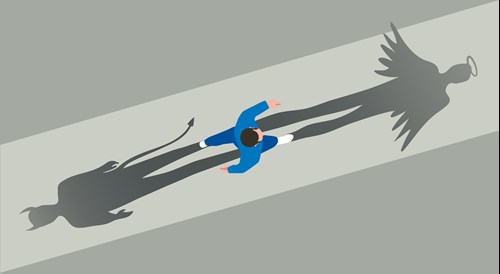Problem solving from another point of view
As teachers and managers, we often have to solve problems, or make decisions that require us to look at different angles and options. Being creative with problem solving when necessary is therefore a good skill to develop, which can be done through greater awareness, proper reflection on problem situations we have been in, and training, especially as managers. A while ago Gerhard Erasmus read a lovely inspiring story that demonstrates how out-of-the-box thinking can help solve problems – that story led to this blog, and evaluating how it relates to our views and perceptions of problem solving.
Many years ago in Italy, there was a loan shark who was a really bad person. A farmer owed him money and couldn’t pay off his debt. The loan shark, who was older than the farmer, offered to erase the debt if the farmer allowed the loan shark to marry the farmer’s daughter. The farmer declined. Eventually it got to the point where the farmer could no longer even afford to pay the interest. The loan shark made another suggestion. He would take two pebbles from the farmer’s garden and place them in a bag. One black pebble and one white pebble. The farmer’s daughter then had to pick a pebble out of the bag. If she picked the white pebble, she would have to marry the loan shark and the debt would be erased. If she picked the black pebble, the debt would still be erased, but she wouldn’t have to marry the loan shark. If they declined, the farmer would lose his farm.

Not having much of a choice, the farmer and his daughter agreed, but the daughter noticed that the loan shark took two white pebbles rather than a black and white pebble. At this point in time, she had three choices:
- Refuse to pick a pebble and her father loses the farm.
- Expose the loan shark as a cheat, but then they would probably still lose the farm and have conflict.
- Sacrifice herself for her father’s sake and pick a pebble.
She picked a pebble out of the bag, but before revealing it, she stumbled and fell over, dropping the pebble she had taken among the other pebbles on the ground. She said, ‘Oops, how clumsy of me. But we can look at which pebble is left in the bag and then would know which one I chose.’
Despite the loan shark being very angry, he had no choice to clear the debt and walk away, or he would have to expose himself as a cheat.
So the moral of the story is: It is possible to overcome difficult situations through out of the box thinking and not only looking at the options in front of you.

What can we really learn from this?
If the whole blog had been this nice little story, then you could stop reading and promote ‘thinking outside the box.’ But there are numerous other more important lessons we can learn from this story – if we look at it in depth, we can learn a lot about problem solving and decision making. I might appear slightly harsh in my analysis of the story, but it is by no means an attempt to discredit an uplifting story. It is purely to highlight the risk of having a happy-go-lucky approach to problem solving.
Being in tough situations
Context point 1: The farmer was in extreme debt
The best way to avoid having to make impossible decisions or trying to problem solve something that perhaps doesn’t really have a solution, is to actually avoid being in tough situations in the first place. Now, unfortunately, there is a lot to be said about the role of debt, the financial industry, and capitalism in general in terms of how it contributes to the difficulties people have in life today as happened in the story – some of which may be unavoidable. However, the main point is to try to avoid getting yourself into such a tough spot by looking for help early on. Ask family and friends, see a mental health specialist, or seek help from a mentor or specialist in the area where you are having problems – you don’t have to problem solve yourself out of situations you can avoid, or just mitigate.

Don’t judge people but know what to expect
Context point 2: The farmer and the daughter knew the loan shark was a bad person
In real life, it isn’t always a struggle between good and evil, and often people we perceive as bad have their own beliefs, or views on life. This might even mean in their eyes that you might be the ‘bad’ person. When dealing with people in problem or conflict situations, figure out what they want or need and use this to your advantage. The daughter in the story knew that the loan shark would not intentionally expose himself as a bad person, so she used this to her advantage.
Even if your boss, or employee, or student, or anyone you encounter come across as a really terrible person, you won’t be able to solve any problems or conflict if you approach it from too high a moral ground. Be reasonable as in most situations (not all) the solution to a problem could be fairly obvious and acceptable to all involved if we could find what we have in common rather than what makes us different.
Use your knowledge, experience and environment
Context point 3: The farmer’s daughter came up with a solution that wasn’t immediately obvious, but she had a massive advantage
What is not immediately obvious from reading the story, and perhaps the reason we are surprised by the ending, is the fact that we cannot see the environment, and like many folk or fairy tales, the characters are fairly flat. But if we consider what happened in the story, we can make a few assumptions about the daughter. The environment in which she solved the problem was her own garden and she saw the pebble path every single day. She might even have played with pebbles and slipped and fell on the path realising she didn’t know which pebble she had in her hand.
If you can solve a problem or deal with a conflict situation in your own environment, you have an advantage. This is also definitely not the first problem this person has solved. Based on the information given in the story about their life, there must have been many issues that she dealt with on a daily basis, and she became a good problem solver not by thinking outside the box, but by becoming an experienced problem solver.

Explore different options and consider the time frame
Context point 4: We are given three options without thinking about it, and the time frame for problem solving is immediate because without it, the story would be boring
If you want to, take a minute or two and think about other possible options to solve the problem. Perhaps the farmer’s daughter would have been a great nurse, or the farmer was close to retirement, and he wanted to move to the beach, or many other options that would have made giving up the farm the best solution. We are also told that the daughter had to make the decision immediately, but she might have had a day or two to come up with her plan.
The key point here is to really consider all other options and to use the time available to make the best possible decision or come up with the best possible solution to a problem. People often come up with poor solutions to problems, because problems are stressful. The faster we come up with a solution, the sooner the problem goes away, and our stress goes away. Ask yourself if the decision or solution was made to make the problem go away, or because it really is the best solution. And, like mentioned earlier on, if you need to find help, find help.

Clear your head to have ‘headspace’ to problem solve
Context point 5: Without saying so in the story, it is fairly safe to assume that the farmer and his daughter wore the same type of clothes every day, they ate the same things for breakfast daily and they had a fairly consistent routine
If you look at very successful people, they often dress fairly similarly every day. Barack Obama is famous for his dark suits, a blue or white shirt, and a blue or red tie. Mark Zuckerberg is synonymous with a grey t-shirt and zip-up hoodie, as was the late Steve Jobs for his black turtleneck and blue denim jeans. And David Attenborough frequently wears a blue shirt and beige trousers. (Just look for pictures of them online). They don’t have to spend hours deciding what to wear. In all likelihood, their cupboard has many duplicate clothing items – all in an effort to avoid decision fatigue (or strive for choice minimalism) so they have more time and energy to concentrate on bigger, more important decisions.
“I'm trying to pare down decisions," Obama said in a 2012 Vanity Fair profile. "I don't want to make decisions about what I'm eating or wearing. Because I have too many other decisions to make."
But it’s fair to say the topic of appearance and fashion is a bit trickier for women; however, some successful businesswomen have opted for more androgynous clothing like suits and others for just one colour – like all black clothing – whilst others simply have a set number of outfits worn on repeat. In doing so, it becomes a uniform as it were, and as such, cuts down on the less important decision making.
I made this change a few years ago and started buying duplicates of everything I liked. So, I have three pairs of identical trousers, and identical shirts, and that means there is no need for me to ‘choose’ what to put on in the morning. I also eat almost exactly the same thing every morning, and that means I don’t have to spend time deciding what to eat.
By having a very solid routine (or fixed mode of dress), over time as it become second nature, it’s possible to eliminate the need to make decisions and problem solve in every single facet of our lives, which thereby allows our brains to spend time thinking about the problems that need greater attention.

Looking forward
The story is very uplifting, and the moral of the story is good in the sense that it encourages us to think outside the box. It does, however, ignore many other important elements of problem solving, not because they are not present, but because they are overlooked. Are there any other elements that story misses that can help with problem solving?
We cannot hope for a world without problems, but we can work to prepare for these problems. We can be better prepared if we are more aware of our limitations and strengths, we reflect on problem situations we have been in and learn from them, and we seek out help and training if needed. Happy problem solving!
References
Hobson, N. (2017). ‘The (Updated) Real Reason Why Famous Founders Wear the Same Clothes Every Day’. Forbes. Jersey City, NJ: Forbes Media LLC.
O’Brien, S. A. (2017). ‘Arianna Huffington advocates for women to repeat outfits’. CNN Business. Atlanta, Georgia: The Cable News Network.

Comments
Write a Comment
Comment Submitted